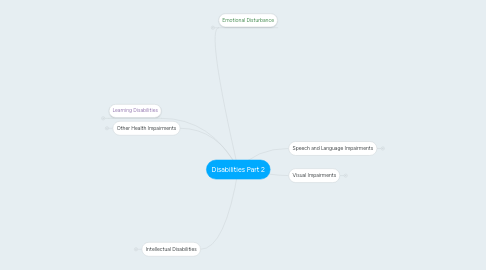Disabilities Part 2
af Holly Chastain

1. Intellectual Disabilities
1.1. a person who has certain limitations in mental functioning and in skills such as communicating, taking care of themselves and social skills
1.2. approximately 6.5 million people in the US have intellectual disabilities
1.3. there is no cure for intellectual disabilities, but children can learn to do many things, it just might take them longer.
1.4. Educational Considerations
1.4.1. supplemental aids/services
1.4.2. teach adaptive skills
1.4.3. show pictures and be as concrete as possible
1.4.4. Give the student immediate feedback
2. Learning Disabilities
2.1. general term that describes specific kinds of learning problems. A learning disability can cause a person to have trouble learning and using certain skills.
2.1.1. The skills affected most are reading, writing, listening, speaking, reasoning, and doing math.
2.2. Other disabilities include: dyslexia, dysgraphia, dyscalculia.
2.3. Signs of a Learning Disability
2.3.1. may have trouble learning the alphabet, rhyming words, or connecting letters to their sounds
2.3.2. may not understand what he or she reads
2.3.3. may struggle to express ideas in writing
2.4. Find out and emphasize what the student’s strengths and interests are and give the student positive feedback and lots of opportunities for practice.
2.5. Learn about the different testing modifications that can really help a student with LD show what he or she has learned.
2.6. Work with the student’s parents to create an IEP tailored to meet the student’s needs.
3. Emotional Disturbance
3.1. IDEA defines this as: “...a condition exhibiting one or more of the follow- ing characteristics over a long period of time and to a marked degree that adversely affects a child’s educational performance"
3.1.1. includes an inability....
3.1.1.1. to learn
3.1.1.1.1. to build or maintain relationships
3.2. characteristics
3.2.1. hyperactivity
3.2.2. acting out; fighting
3.2.3. withdrawal
3.3. umbrella term for: anxiety disorder, bipolar disorder, conduct disorder, eating disorders, OCD, psychotic disorders
3.4. Educational programs for children with an emotional disturbance need to include attention to providing emotional and behavioral support as well as helping them to master academics, develop social skills, and increase self- awareness, self-control, and self- esteem.
4. Other Health Impairments
4.1. means having limited strength, vitality, or alert- ness, including a height- ened alertness to environ- mental stimuli, that results in limited alertness with respect to the educational environment
4.2. falls under the category if they have limited strength, vitality, or alertness due to chronic health problems; and an educational performance that is negatively affected as a result.
4.3. includes: ADHD/ADD, diabetes, leukemia, lead poisoning, heart conditions
4.4. for teachers: Related services are provided as required to enable children with disabilities to benefit from their special education.
4.5. Determining what related services a child needs is the responsibility of the child’s IEP team, the group that develops the child’s individualized education program. Key information will be available from the evaluation process, since a child must be assessed in all areas related to his or her suspected disability.
4.6. Planning for transitions: After a child has been out of school for an extended period of time, it’s important for parents and school staff to plan carefully for his or her return to school and the activities that go on there.
5. Speech and Language Impairments
5.1. 4 major areas where it occurs: articulation, fluency, voice, language
5.2. language delay is different
5.3. characteristics: leaving out certain sounds, trouble with flow of speech, problems with pitch, loudness, or quality of voice, unable to understand text.
5.4. educational considerations: make use of speech language pathology services and assistive technology
6. Visual Impairments
6.1. defined as partially sighted, low vision, legally blind, and totally blind are used in the educational context to describe students with visual impairments
6.2. Visual impairment is the consequence of a functional loss of vision, rather than the eye disorder itself. Eye disorders which can lead to visual impairments can include retinal degeneration, albinism, cataracts, glaucoma, muscular problems that result in visual disturbances, corneal disorders, diabetic retinopathy, congenital disorders, and infection.
6.3. Many children who have multiple disabilities may also have visual impairments resulting in motor, cognitive, and/or social developmental delays.
6.4. Education implications: Use technology in the form of computers and low-vision optical and video aids enable many partially sighted, low vision, and blind children to participate in regular class activities. Large print materials, books on tape, and braille books are available.
6.5. Students with visual impairments may need additional help with special equipment and modifications in the regular curriculum to emphasize listening skills, communi- cation, orientation and mobility, vocation/career options, and daily living skills.


